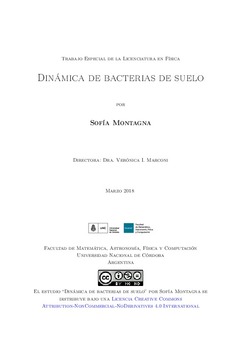| dc.contributor.advisor | Marconi, Verónica Iris, dir. | |
| dc.contributor.author | Montagna, Sofía | |
| dc.date.accessioned | 2018-05-22T13:43:22Z | |
| dc.date.available | 2018-05-22T13:43:22Z | |
| dc.date.issued | 2018-03 | |
| dc.identifier.uri | http://hdl.handle.net/11086/6220 | |
| dc.description | Tesis (Lic. en Física)--Universidad Nacional de Córdoba, Facultad de Matemática, Astronomía, Física y Computación, 2018. | es |
| dc.description.abstract | Dado que la movilidad de las bacterias en el suelo no puede ser observada in vivo al microscopio, el diseño de dispositivos que imiten la porosidad y tortuosidad de los canales del suelo y al mismo tiempo sean transparentes y biocompatibles puede contribuir a una mejor comprensión de este fenómeno y a aplicaciones biotecnológicas. Con esta motivación y enfoque interdisciplinario se estudiaron numéricamente las propiedades de transporte de poblaciones de bacterias de suelo Bradyrhizobium diazoefficiens, utilizando dinámica de Langevin. Las simulaciones se realizaron en un medio bidimensional con diferentes tipos de obstáculos, tarea menos costosa numéricamente que experimentalmente. En primer lugar se analizaron las estrategias de nado reales de las bacterias en un medio acuoso sin obstáculos y se lograron reproducir con un buen acuerdo teórico-experimental, obteniendo así parámetros para un modelado sin ajustes. Se estudió el desplazamiento cuadrático medio de las poblaciones y el coeficiente de difusión traslacional y su relación con el tipo de medio en el que las bacterias están inmersas, para diferentes cepas. Esto nos permitió realizar una caracterización de las propiedades de transporte relacionadas a cada sistema flagelar. El estudio de las propiedades de transporte de estas bacterias que se encuentran en el suelo cerca de las raíces, tiene como fin contribuir a la mejora de los biofertilizantes utilizados en los cultivos de soja para lograr una agronomía más sustentable. | es |
| dc.description.abstract | Since bacteria motility cannot be bserved in vivo into the soil at the microscope, device designs that mimics the porosity and tortuosity of real soil could contribute to a better understanding of this phenomenon. Such devices, transparent and biocompatible, present advantages for biotechnological applications. Under this motivation and interdisciplinary approach, the transport properties of soil bacteria Bradyrhizobium diazoefficiens populations were studied numerically, using Langevin dynamics. The simulations were carried out in two-dimensions with different types of obstacles, a numerically costless task than experimentally. Firstly the actual swimming strategies of the bacteria were analyzed in an aqueous medium without obstacles and they were reproduced with a good theoretical-experimental agreement. Thus real parameters without adjustments were obtained for the model. The population mean square displacement, the translational diffusion coefficient and its relation to the type of medium in which bacteria are immersed were studied,for different strains. This allowed us to
perform a characterization of the transport properties related to each flagellar system. The study of the transport properties of these soil bacteria, found near the roots, aim to contribute to the improvement of biofertilizers used in the soybean crops to achieve a more sustainable agronomy. | en |
| dc.language.iso | spa | es |
| dc.rights | Attribution-NonCommercial-NoDerivatives 4.0 Internacional | * |
| dc.rights.uri | http://creativecommons.org/licenses/by-nc-nd/4.0/ | * |
| dc.subject | Stochastic modeling | en |
| dc.subject | MD Simulation | en |
| dc.subject.other | Bacteria | es |
| dc.subject.other | Transporte | es |
| dc.subject.other | Poros | es |
| dc.title | Dinámica de bacterias de suelo | es |
| dc.type | bachelorThesis | es |





